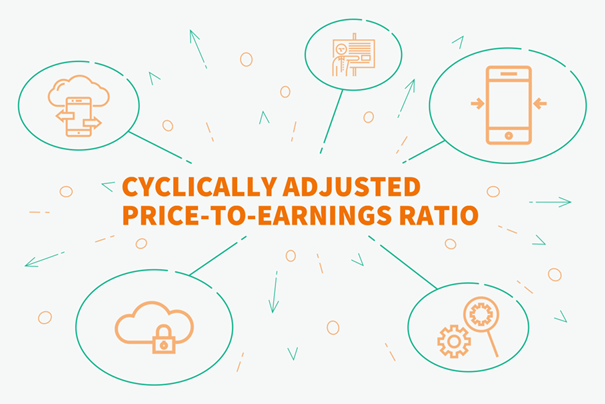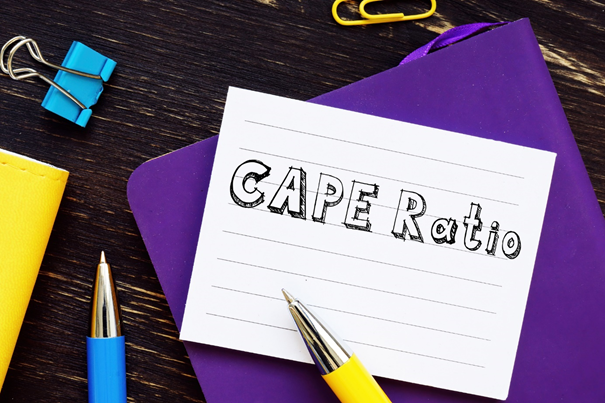CAPE Ratio
Updated on 2023-08-29T11:55:19.823070Z
What is CAPE Ratio?
The CAPE (Cyclically Adjusted Price-to-Earnings) Ratio is calculated by dividing a company’s stock price by the average of a company’s inflation-adjusted earnings over ten years. CAPE ratio is also known as Shiller P/E or PE 10 Ratio.
It is widely used to measure the valuation of the S&P 500 index. The Shiller PE of the Standard and Poor's 500 (S&P 500) currently stood at just over 30 (as of early August 2020). Investors use CAPE Ratio to determine whether the price of a stock is correct or not. They also use the ratio as a valuation metric to forecast future returns.

Image source: OpturaDesign, Shutterstock
Formula to calculate CAPE Ratio
Summary
- CAPE Ratio is used by financial analysts to assess long-term financial performance while isolating the impact of economic cycles. It suggests whether a stock is overvalued or undervalued.
- CAPE ratio was invented by an American economist, Robert Shiller.
- Cape Ratio is similar to (P/E) ratio and is used to analyze the financial performance of a publicly held company.
Frequently Asked Questions (FAQs)
What is the relation between CAPE Ratio, Earning Per Share (EPS) and (P/E) ratio?
Cape Ratio is considered similar to the Price-to-Earnings (P/E) ratio. P/E ratio tells you whether the price accurately reflects its earnings potential or its value over time.
It is the company’s market value per share to its Earning per Share. Earnings Per Share is equal to a company’s profit divided by number of outstanding shares.
An exceptionally high CAPE ratio implies that a company’s stock price is considerably higher than the earnings would suggest. This indicates that the stock is overvalued. It is believed that the market will ultimately push down the company’s stock price to its true value, thus correcting it.
How can the CAPE Ratio help us understand the financial situation of a country?
The CAPE ratio has played an important role in spotting potential bubbles and market crashes. The highest level of the ratio for the S&P 500 Index is over 30. The history of the US financial markets witnessed record-high levels three times. The first was in 1929 before the Wall Street crash that marked the start of the Great Depression. The second was in the late 1990s before the Dotcom Crash, and the third was in 2007 before the 2007-2008 Financial Crisis. Furthermore, lower CAPE ratio indicates higher returns for investors over time.
What are the advantages and disadvantages of CAPE Ratio?
Advantages of Cape Ratio
- CAPE ratio plays an important role in the identification of unusual bubbles, forecasting their bursts, and market crashes.
- Any change in CAPE Ratio affects the average returns. For instance, when the CAPE is between 10-15, the returns average is around 8 percent per year. Moreover, when the CAPE ratio is between 15 and 20, the yields average 5 percent per year. As the CAPE ratio increases to 20 and 25, the average returns come down to 3 percent per annum. With the CAPE higher than 25, the average returns fall to around 1 percent per year.
- CAPE ratio plays a vital role in spotting potential bubbles and market crashes.
- CAPE Ratio can help in the predictability of near-term capital market returns.
Disadvantages of Cape Ratio
- Critics of the CAPE ratio maintain that it is not that useful in analyzing the financial performance of a company as the method is backward looking rather than forward looking. Another contention is that the CAPE ratio relies on GAAP (generally accepted accounting principles) earnings and does not consider the changes in the accounting rules which have occurred over the recent years. GAAP provides a pessimistic view of future earnings.
- Some analysts also assert that instead of GAAP earnings, usage of consistent earnings data like the operating earnings or the or NIPA (national income and product account) after-tax corporate profits, improves the predicting ability of the CAPE model and predicts higher US equity returns.
- CAPE Ratio does not consider the dividend yield and ignores the risk-free rate investments in the market like the sovereign yield bonds.
- Moreover, it is believed that this method ignores the demand-supply function, which is one of the most important pillars of economics.
- Choice and investment patterns of people do not remain same always and changes over a period of time.

Source: © Rummess | Megapixl.com
What is the current situation of the stock market with regard to CAPE Ratio?
Based on the CAPE ratio, the most expensive stock markets (among the 25 largest economies measured by their Gross Domestic Product or GDP) can be found from the US, India, and Japan. The most undervalued countries are Poland, Russia, and Turkey.
The investors might find it difficult to decide whether to sell all their US stocks and buy Russian and Turkish equities instead. The CAPE ratio of Russia looks temptingly low, but it is worth remembering that the CAPE Ratio of the country has been lower than 10 since the financial crisis of 2007-2008. Hence, based on the average valuations of the Russian stock market for the last ten years, the Moscow Stock Exchange looks actually quite expensive. Turkey’s valuation multiples are at present evidently lower than they have been in the past but given the current political turmoil in the country the low valuations can easily be justified.